Yashuai Cao
Beamforming-Codebook-Aware Channel Knowledge Map Construction for Multi-Antenna Systems
May 22, 2025Abstract:Channel knowledge map (CKM) has emerged as a crucial technology for next-generation communication, enabling the construction of high-fidelity mappings between spatial environments and channel parameters via electromagnetic information analysis. Traditional CKM construction methods like ray tracing are computationally intensive. Recent studies utilizing neural networks (NNs) have achieved efficient CKM generation with reduced computational complexity and real-time processing capabilities. Nevertheless, existing research predominantly focuses on single-antenna systems, failing to address the beamforming requirements inherent to MIMO configurations. Given that appropriate precoding vector selection in MIMO systems can substantially enhance user communication rates, this paper presents a TransUNet-based framework for constructing CKM, which effectively incorporates discrete Fourier transform (DFT) precoding vectors. The proposed architecture combines a UNet backbone for multiscale feature extraction with a Transformer module to capture global dependencies among encoded linear vectors. Experimental results demonstrate that the proposed method outperforms state-of-the-art (SOTA) deep learning (DL) approaches, yielding a 17\% improvement in RMSE compared to RadioWNet. The code is publicly accessible at https://github.com/github-whh/TransUNet.
Lightweight and Self-Evolving Channel Twinning: An Ensemble DMD-Assisted Approach
Apr 23, 2025



Abstract:Traditional channel acquisition faces significant limitations due to ideal model assumptions and scalability challenges. A novel environment-aware paradigm, known as channel twinning, tackles these issues by constructing radio propagation environment semantics using a data-driven approach. In the spotlight of channel twinning technology, a radio map is recognized as an effective region-specific model for learning the spatial distribution of channel information. However, most studies focus on static channel map construction, with only a few collecting numerous channel samples and using deep learning for radio map prediction. In this paper, we develop a novel dynamic radio map twinning framework with a substantially small dataset. Specifically, we present an innovative approach that employs dynamic mode decomposition (DMD) to model the evolution of the dynamic channel gain map as a dynamical system. We first interpret dynamic channel gain maps as spatio-temporal video stream data. The coarse-grained and fine-grained evolving modes are extracted from the stream data using a new ensemble DMD (Ens-DMD) algorithm. To mitigate the impact of noisy data, we design a median-based threshold mask technique to filter the noise artifacts of the twin maps. With the proposed DMD-based radio map twinning framework, numerical results are provided to demonstrate the low-complexity reproduction and evolution of the channel gain maps. Furthermore, we consider four radio map twin performance metrics to confirm the superiority of our framework compared to the baselines.
Channel Twinning: An Enabler for Next-Generation Ubiquitous Wireless Connectivity
Jun 18, 2024



Abstract:The emerging concept of channel twinning (CT) has great potential to become a key enabler of ubiquitous connectivity in next-generation (xG) wireless systems. By fusing multimodal sensor data, CT advocates a high-fidelity and low-overhead channel acquisition paradigm, which is promising to provide accurate channel prediction in cross-domain and high-mobility scenarios of ubiquitous xG networks. However, the current literature lacks a universal CT architecture to address the challenges of heterogeneous scenarios, data, and resources in xG networks, which hinders the widespread deployment and applications of CT. This article discusses a new modularized CT architecture to bridge the barriers to scene recognition, cooperative sensing, and decentralized training. Based on the modularized design of CT, universal channel modeling, multimodal cooperative sensing, and lightweight twin modeling are described. Moreover, this article provides a concise definition, technical features, and case studies of CT, followed by potential applications of CT-empowered ubiquitous connectivity and some issues requiring future investigations.
Multi-Objective Optimization-Based Waveform Design for Multi-User and Multi-Target MIMO-ISAC Systems
May 22, 2024Abstract:Integrated sensing and communication (ISAC) opens up new service possibilities for sixth-generation (6G) systems, where both communication and sensing (C&S) functionalities co-exist by sharing the same hardware platform and radio resource. In this paper, we investigate the waveform design problem in a downlink multi-user and multi-target ISAC system under different C&S performance preferences. The multi-user interference (MUI) may critically degrade the communication performance. To eliminate the MUI, we employ the constructive interference mechanism into the ISAC system, which saves the power budget for communication. However, due to the conflict between C&S metrics, it is intractable for the ISAC system to achieve the optimal performance of C&S objective simultaneously. Therefore, it is important to strike a tradeoff between C&S objectives. By virtue of the multi-objective optimization theory, we propose a weighted Tchebycheff-based transformation method to re-frame the C&S trade-off problem as a Pareto-optimal problem, thus effectively tackling the constraints in ISAC systems. Finally, simulation results reveal the trade-off relation between C&S performances, which provides insights for the flexible waveform design under different C&S performance preferences in MIMO-ISAC systems.
Intelligent Reflecting Surfaces and Next Generation Wireless Systems
Feb 27, 2024Abstract:Intelligent reflecting surface (IRS) is a potential candidate for massive multiple-input multiple-output (MIMO) 2.0 technology due to its low cost, ease of deployment, energy efficiency and extended coverage. This chapter investigates the slot-by-slot IRS reflection pattern design and two-timescale reflection pattern design schemes, respectively. For the slot-by-slot reflection optimization, we propose exploiting an IRS to improve the propagation channel rank in mmWave massive MIMO systems without need to increase the transmit power budget. Then, we analyze the impact of the distributed IRS on the channel rank. To further reduce the heavy overhead of channel training, channel state information (CSI) estimation, and feedback in time-varying MIMO channels, we present a two-timescale reflection optimization scheme, where the IRS is configured relatively infrequently based on statistical CSI (S-CSI) and the active beamformers and power allocation are updated based on quickly outdated instantaneous CSI (I-CSI) per slot. The achievable average sum-rate (AASR) of the system is maximized without excessive overhead of cascaded channel estimation. A recursive sampling particle swarm optimization (PSO) algorithm is developed to optimize the large-timescale IRS reflection pattern efficiently with reduced samplings of channel samples.
Multi-Carrier NOMA-Empowered Wireless Federated Learning with Optimal Power and Bandwidth Allocation
Feb 13, 2023



Abstract:Wireless federated learning (WFL) undergoes a communication bottleneck in uplink, limiting the number of users that can upload their local models in each global aggregation round. This paper presents a new multi-carrier non-orthogonal multiple-access (MC-NOMA)-empowered WFL system under an adaptive learning setting of Flexible Aggregation. Since a WFL round accommodates both local model training and uploading for each user, the use of Flexible Aggregation allows the users to train different numbers of iterations per round, adapting to their channel conditions and computing resources. The key idea is to use MC-NOMA to concurrently upload the local models of the users, thereby extending the local model training times of the users and increasing participating users. A new metric, namely, Weighted Global Proportion of Trained Mini-batches (WGPTM), is analytically established to measure the convergence of the new system. Another important aspect is that we maximize the WGPTM to harness the convergence of the new system by jointly optimizing the transmit powers and subchannel bandwidths. This nonconvex problem is converted equivalently to a tractable convex problem and solved efficiently using variable substitution and Cauchy's inequality. As corroborated experimentally using a convolutional neural network and an 18-layer residential network, the proposed MC-NOMA WFL can efficiently reduce communication delay, increase local model training times, and accelerate the convergence by over 40%, compared to its existing alternative.
Two-Timescale Optimization for Intelligent Reflecting Surface-Assisted MIMO Transmission in Fast-Changing Channels
Jun 15, 2022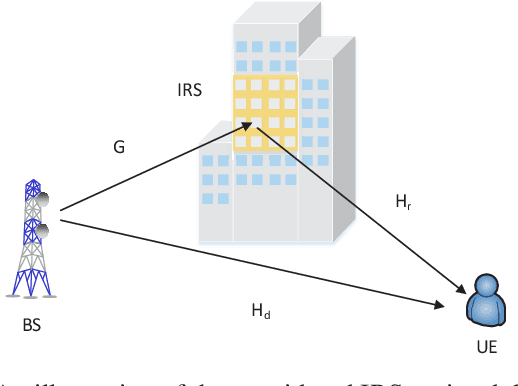
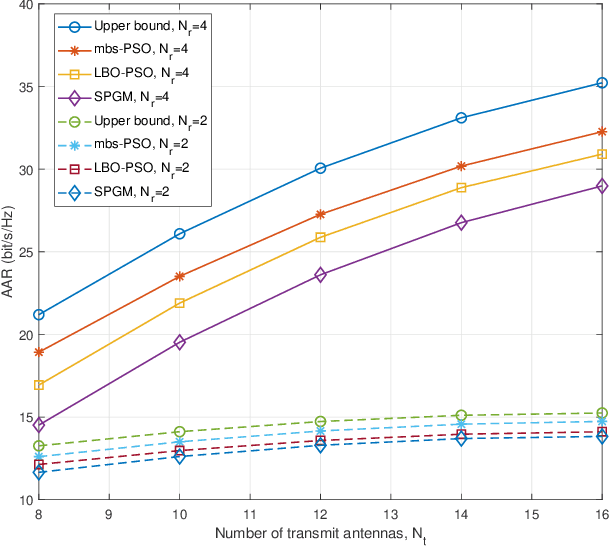
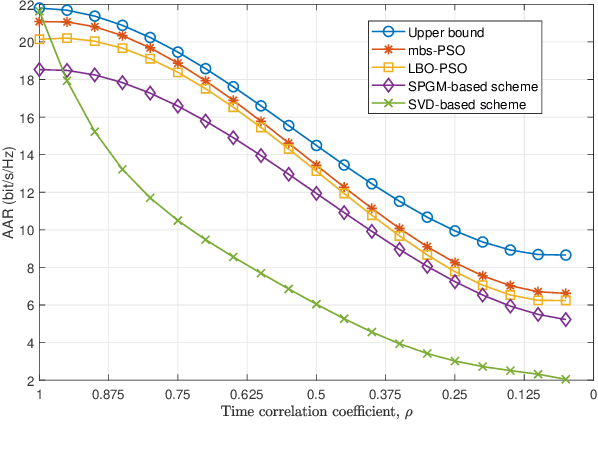
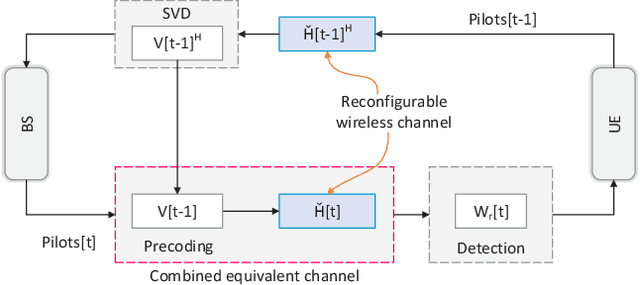
Abstract:The application of intelligent reflecting surface (IRS) depends on the knowledge of channel state information (CSI), and has been hindered by the heavy overhead of channel training, estimation, and feedback in fast-changing channels. This paper presents a new two-timescale beamforming approach to maximizing the average achievable rate (AAR) of IRS-assisted MIMO systems, where the IRS is configured relatively infrequently based on statistical CSI (S-CSI) and the base station precoder and power allocation are updated frequently based on quickly outdated instantaneous CSI (I-CSI). The key idea is that we first reveal the optimal small-timescale power allocation based on outdated I-CSI yields a water-filling structure. Given the optimal power allocation, a new mini-batch sampling (mbs)- based particle swarm optimization (PSO) algorithm is developed to optimize the large-timescale IRS configuration with reduced channel samples. Another important aspect is that we develop a model-driven PSO algorithm to optimize the IRS configuration, which maximizes a lower bound of the AAR by only using the S-CSI and eliminates the need of channel samples. The modeldriven PSO serves as a dependable lower bound for the mbs-PSO. Simulations corroborate the superiority of the new two-timescale beamforming strategy to its alternatives in terms of the AAR and efficiency, with the benefits of the IRS demonstrated.
Downlink Power Minimization in Intelligent Reconfigurable Surface-Aided Security Classification Wireless Communications System
Jun 11, 2022
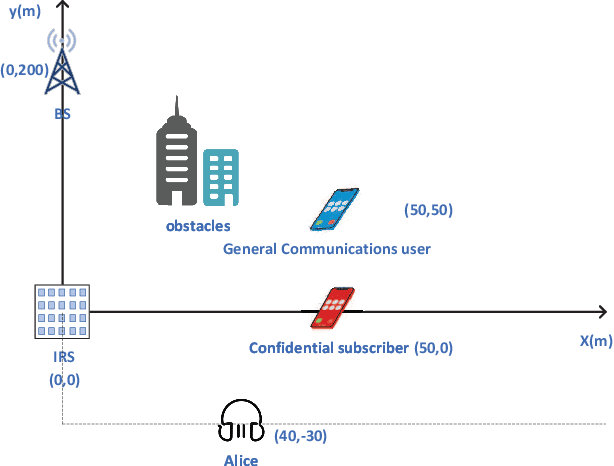
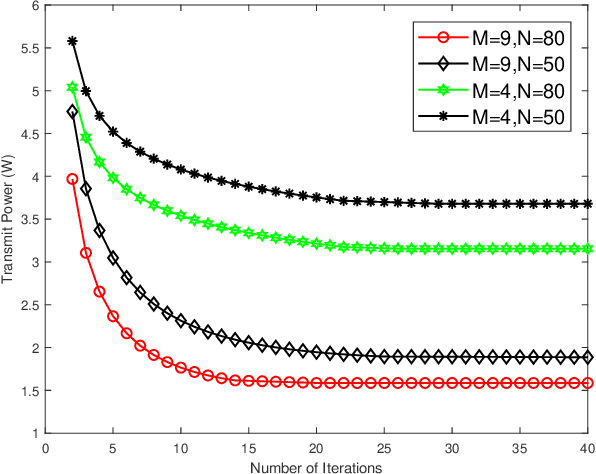
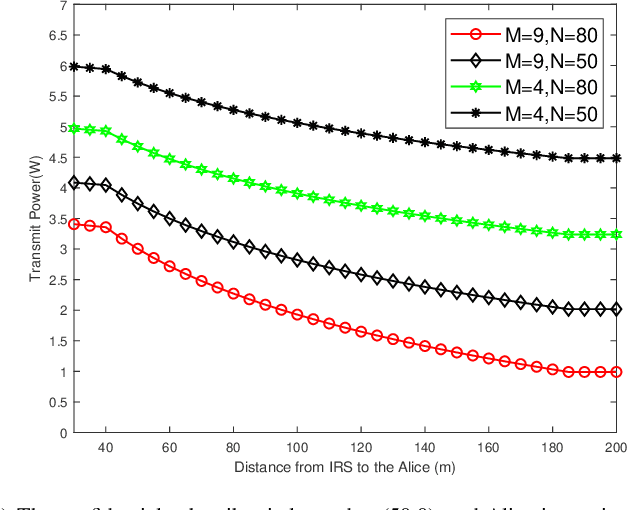
Abstract:User privacy protection is considered a critical issue in wireless networks, which drives the demand for various secure information interaction techniques. In this paper, we introduce an intelligent reflecting surface (IRS)-aided security classification wireless communication system, which reduces the transmit power of the base station (BS) by classifying users with different security requirements. Specifically, we divide the users into confidential subscribers with secure communication requirements and general communication users with simple communication requirements. During the communication period, we guarantee the secure rate of the confidential subscribers while ensuring the service quality of the general communication users, thereby reducing the transmit power of the BS. To realize such a secure and green information transmission, the BS implements a beamforming design on the transmitted signal superimposed with artificial noise (AN) and then broadcasts it to users with the assistance of the IRS's reflection. We develop an alternating optimization framework to minimize the BS downlink power with respect to the active beamformers of the BS, the AN vector at the BS, and the reflection phase shifts of the IRS. A successive convex approximation (SCA) method is proposed so that the nonconvex beamforming problems can be converted to tractable convex forms. The simulation results demonstrate that the proposed algorithm is convergent and can reduce the transmit power by 20\% compared to the best benchmark scheme.
Sum-Rate Maximization for Multi-Reconfigurable Intelligent Surface-Assisted Device-to-Device Communications
Aug 16, 2021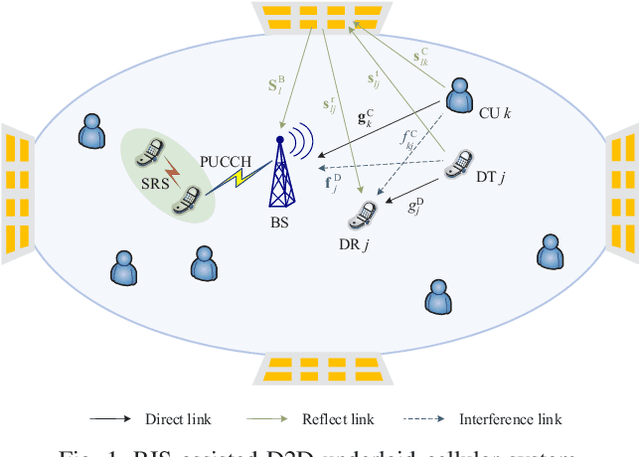
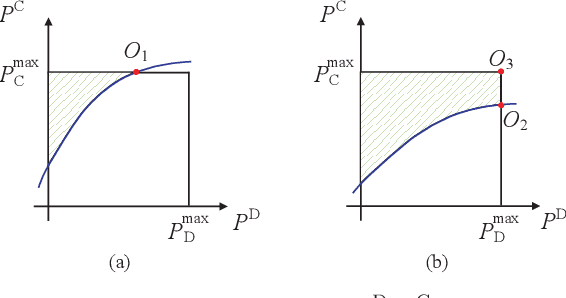
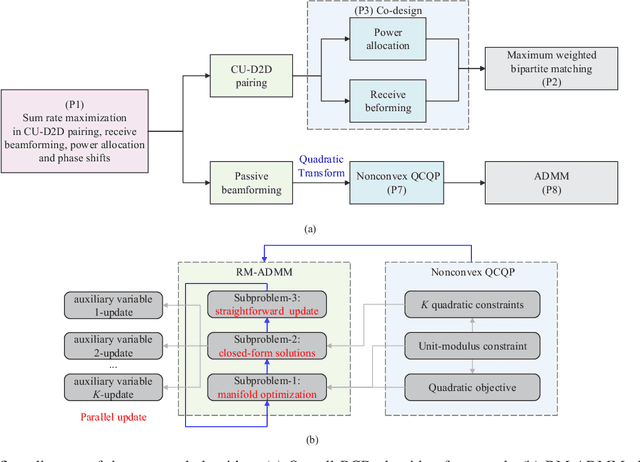
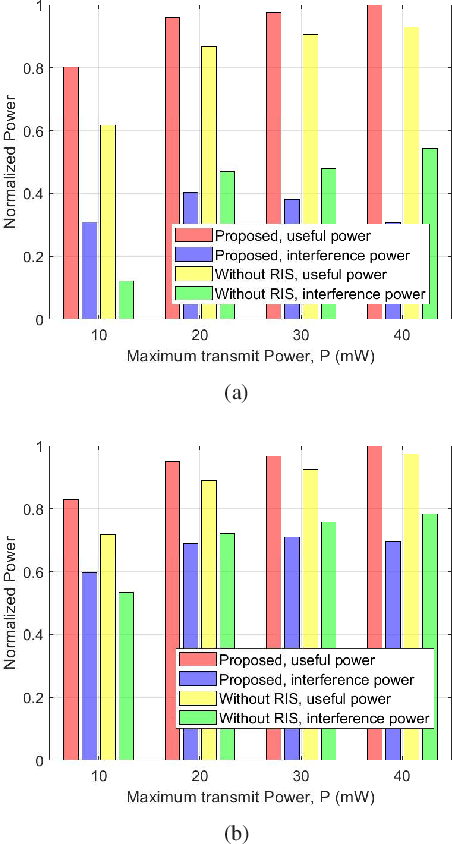
Abstract:This paper proposes to deploy multiple reconfigurable intelligent surfaces (RISs) in device-to-device (D2D)-underlaid cellular systems. The uplink sum-rate of the system is maximized by jointly optimizing the transmit powers of the users, the pairing of the cellular users (CUs) and D2D links, the receive beamforming of the base station (BS), and the configuration of the RISs, subject to the power limits and quality-of-service (QoS) of the users. To address the non-convexity of this problem, we develop a new block coordinate descent (BCD) framework which decouples the D2D-CU pairing, power allocation and receive beamforming, from the configuration of the RISs. Specifically, we derive closed-form expressions for the power allocation and receive beamforming under any D2D-CU pairing, which facilitates interpreting the D2D-CU pairing as a bipartite graph matching solved using the Hungarian algorithm. We transform the configuration of the RISs into a quadratically constrained quadratic program (QCQP) with multiple quadratic constraints. A low-complexity algorithm, named Riemannian manifold-based alternating direction method of multipliers (RM-ADMM), is developed to decompose the QCQP into simpler QCQPs with a single constraint each, and solve them efficiently in a decentralized manner. Simulations show that the proposed algorithm can significantly improve the sum-rate of the D2D-underlaid system with a reduced complexity, as compared to its alternative based on semidefinite relaxation (SDR).
 Add to Chrome
Add to Chrome Add to Firefox
Add to Firefox Add to Edge
Add to Edge